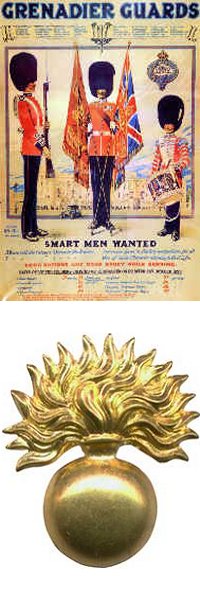yeovil at War
Frank George Chester
Died from wounds sustained in the Retreat from Mons
All we know about Frank George Chester before he joined the army is that he was born in Yeovil and had a sister, Ethel Rose, who was also born in Yeovil at the beginning of 1885. Certainly by 1914 their parents had died and Ethel was Frank's next of kin. I could find no further trace of Frank in civil records.
 It
is most likely
that Frank was a
career soldier,
enlisting at
Southampton and
joining the 2nd
Battalion,
Grenadier Guards
as a Guardsman.
His Service
Number of 16305
denotes he
enlisted in the
summer of 1913.
It
is most likely
that Frank was a
career soldier,
enlisting at
Southampton and
joining the 2nd
Battalion,
Grenadier Guards
as a Guardsman.
His Service
Number of 16305
denotes he
enlisted in the
summer of 1913.
In August 1914, immediately before the outbreak of war, the 2nd Battalion, Grenadier Guards were stationed in Chelsea Barracks as part of the 4th (Guards) Brigade of 2nd Division.
When war broke out the Battalion sailed for France almost straight away as part of the British Expeditionary Force (BEF), landing at Le Havre on 15 August 1914. Indeed the 2nd Division was one of the first British formations to move to France, where it remained on the Western Front throughout the war.
The 2nd Battalion were straight into battle and took part in the Battle of Mons.
The Battle of Mons, 23 August 1914, was part of the wider Battle of the Frontiers. It was the first battle fought by the BEF since its arrival in France. On 22 August the five divisions of the BEF (four infantry and one cavalry) reached the Mons-Condé canal and took up positions along twenty miles of the canal. Sir John French, the commander of the BEF, had been expecting to join a French offensive into Belgium, but this plan had been based on a misunderstanding of the German plan. On 22 August the French had suffered a serious setback at the Sambre, when their Fifth Army had been attacked by the German Second and Third Armies.
During the night of 22 August 1914 Sir John French received a request to launch a counterattack against what was believed to be the right flank of the German army advancing through Belgium. This belief was mistaken. The German First Army was advancing directly towards the British position - there was no open flank to attack. On 23 August the First Army collided with the thin British line. 70,000 British soldiers with 300 guns faced as many as 160,000 Germans, supported by 600 guns. Although they were badly outnumbered, the British did have two big advantages. Both came from the professional volunteer nature of the British army. The British regular soldier of 1914 was expected to be able to fire fifteen aimed shots per minute. At Mons the British rifle fire was so rapid and so accurate that many Germans believed they had been facing massed machine guns.
Although the British fought well and inflicted disproportionate casualties on the numerically superior Germans, they were eventually forced to retreat due both to the greater strength of the Germans and the sudden retreat of the French Fifth Army, which exposed the British right flank. Though initially planned as a simple tactical withdrawal and executed in good order, the British retreat from Mons lasted for two weeks and took the BEF to the outskirts of Paris before it counter-attacked in concert with the French, at the Battle of the Marne.
During the retreat from Mons, Frank Chester was wounded during a rearguard action fought by the 4th (Guards) Brigade on 1 September 1914 and died of his wounds on 2 September 1914. He was interred in the collective Guards Grave, Villers Cotterets Forest.
By the time of his death his only known relative was his sister Ethel. Ethel had moved away and married Anthony Sohn at Christchurch, Dorset, in 1910. His name was added to the War Memorial in the Borough in 2018.
gallery

The Commonwealth War Graves Commission's certificate commemorating Frank Chester.